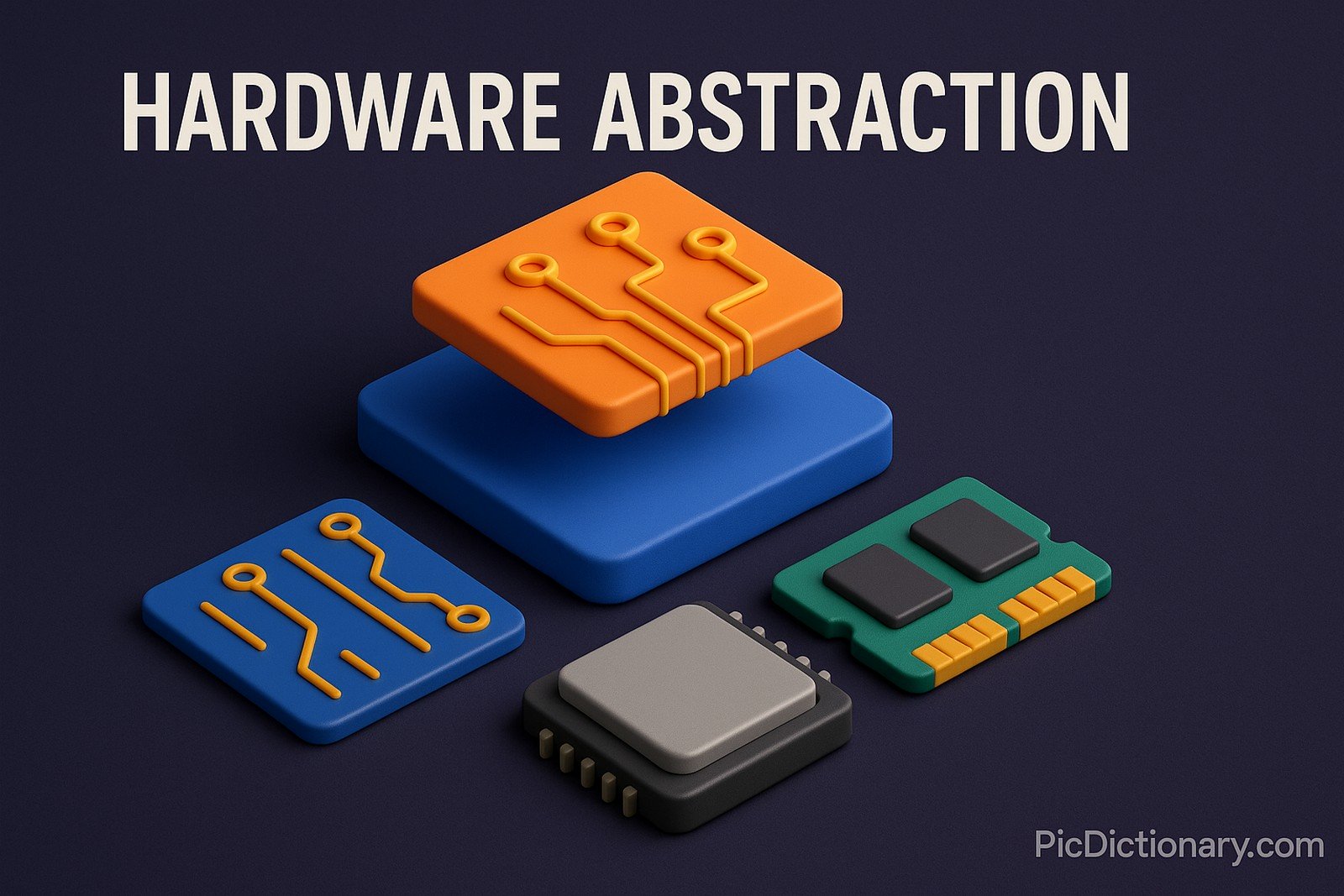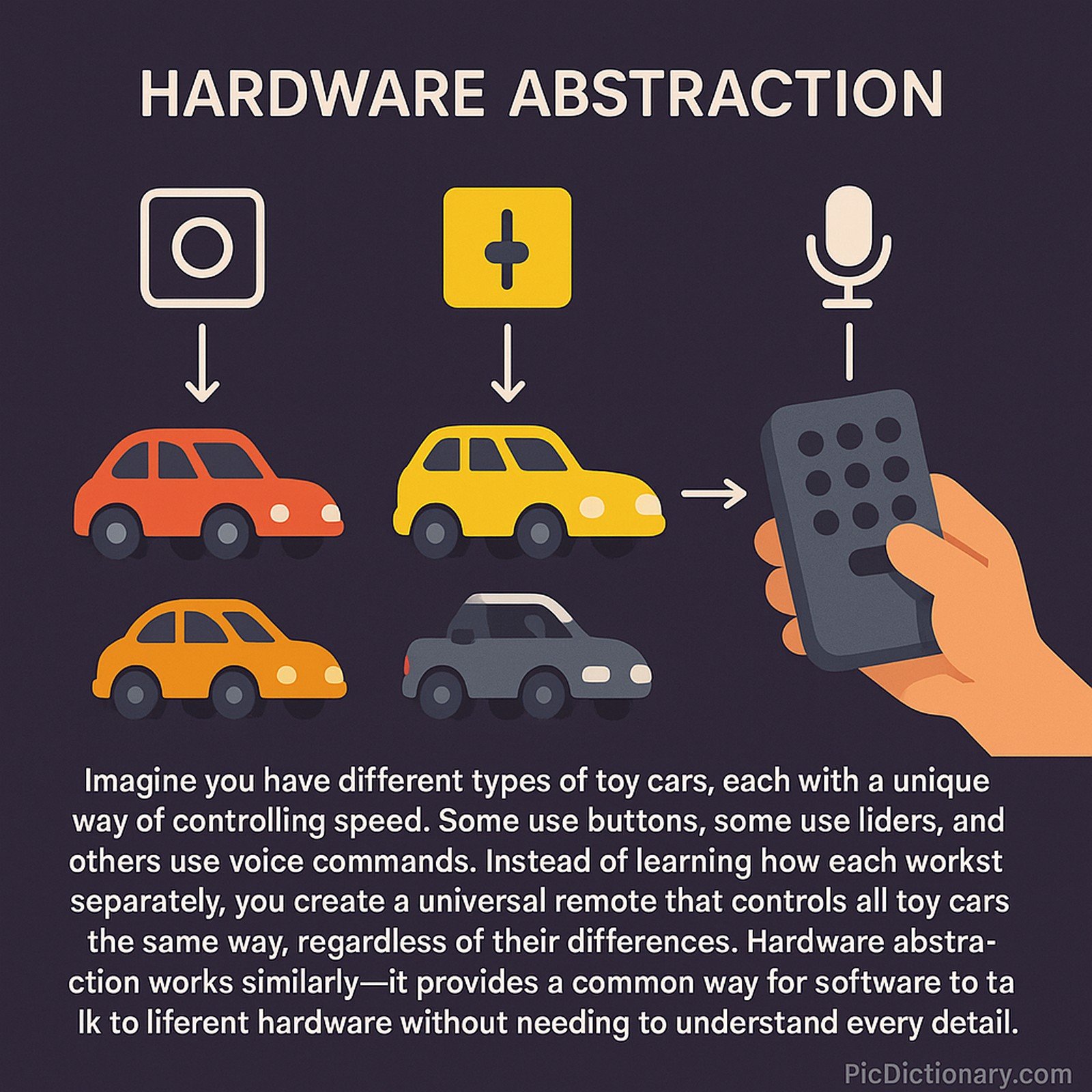Hardware Abstraction

Quick Navigation:
- Hardware Abstraction Definition
- Hardware Abstraction Explained Easy
- Hardware Abstraction Origin
- Hardware Abstraction Etymology
- Hardware Abstraction Usage Trends
- Hardware Abstraction Usage
- Hardware Abstraction Examples in Context
- Hardware Abstraction FAQ
- Hardware Abstraction Related Words
Hardware Abstraction Definition
Hardware abstraction refers to the process of creating a simplified, uniform interface for interacting with different hardware components. It allows software to communicate with hardware without needing to understand its low-level details. By using a hardware abstraction layer (HAL), developers can write code that is portable across different hardware architectures, improving software compatibility and maintainability. Operating systems and embedded systems often utilize hardware abstraction to standardize hardware access.
Hardware Abstraction Explained Easy
Imagine you have different types of toy cars, each with a unique way of controlling speed. Some use buttons, some use sliders, and others use voice commands. Instead of learning how each works separately, you create a universal remote that controls all toy cars the same way, regardless of their differences. Hardware abstraction works similarly—it provides a common way for software to talk to different hardware without needing to understand every detail.
Hardware Abstraction Origin
The concept of hardware abstraction emerged in the early days of computing as developers sought ways to write software that could function on multiple hardware platforms. Early operating systems, such as UNIX, introduced layers that separated software from hardware specifics, laying the foundation for modern hardware abstraction techniques.
Hardware Abstraction Etymology
The term "hardware abstraction" comes from the idea of abstraction, which means hiding complexity while providing essential functionality. It involves creating a simplified model of hardware interactions to make development easier.
Hardware Abstraction Usage Trends
With the rise of cross-platform development and cloud computing, hardware abstraction has become increasingly important. Virtualization, containerization, and cloud-based infrastructure rely on hardware abstraction to enable software to run on different hardware environments seamlessly. The automotive, gaming, and IoT industries also use hardware abstraction layers to ensure compatibility across diverse hardware configurations.
Hardware Abstraction Usage
- Formal/Technical Tagging:
- Operating Systems
- Virtualization
- Embedded Systems
- Hardware Interfaces - Typical Collocations:
- "hardware abstraction layer (HAL)"
- "abstraction for device drivers"
- "software-hardware interface"
- "standardized hardware communication"
Hardware Abstraction Examples in Context
- An operating system uses a hardware abstraction layer to ensure applications can run on different processor architectures.
- Gaming consoles use hardware abstraction to allow game developers to create software without worrying about the specifics of the underlying hardware.
- Virtual machines rely on hardware abstraction to run multiple operating systems on a single physical machine.
Hardware Abstraction FAQ
- What is hardware abstraction?
Hardware abstraction is a technique that allows software to interact with hardware through a common interface, making it independent of hardware specifics. - Why is hardware abstraction important?
It simplifies software development, improves compatibility across different hardware, and reduces dependency on specific hardware vendors. - What is a hardware abstraction layer (HAL)?
A HAL is a software layer that provides a standardized way for applications to communicate with hardware components. - How does hardware abstraction benefit operating systems?
It enables OS developers to support multiple hardware architectures without modifying core system functionality. - Is hardware abstraction used in embedded systems?
Yes, embedded systems use hardware abstraction to ensure software portability across different microcontrollers and processors. - How does hardware abstraction relate to virtualization?
Virtualization technologies use hardware abstraction to allow multiple virtual machines to share physical hardware resources. - Can hardware abstraction improve software security?
Yes, by controlling direct hardware access, it can help enforce security policies and prevent unauthorized access. - Is hardware abstraction relevant in cloud computing?
Absolutely, cloud platforms use hardware abstraction to allow applications to run on various underlying hardware setups seamlessly. - Does hardware abstraction affect system performance?
While it adds a layer of abstraction, modern implementations are optimized to minimize performance overhead. - How do game consoles use hardware abstraction?
They provide a unified development environment, enabling game developers to focus on software rather than hardware differences.

Hardware Abstraction Related Words
- Categories/Topics:
- Operating Systems
- Computer Architecture
- Virtualization
- Software Engineering
Did you know?
Many modern video game consoles use hardware abstraction to ensure backward compatibility. This allows older games to run on newer consoles by translating their hardware-specific instructions into a universal format.
PicDictionary.com is an online dictionary in pictures. If you have questions or suggestions, please reach out to us on WhatsApp or Twitter.Authors | Arjun Vishnu | @ArjunAndVishnu

I am Vishnu. I like AI, Linux, Single Board Computers, and Cloud Computing. I create the web & video content, and I also write for popular websites.
My younger brother, Arjun handles image & video editing. Together, we run a YouTube Channel that's focused on reviewing gadgets and explaining technology.



Comments powered by CComment